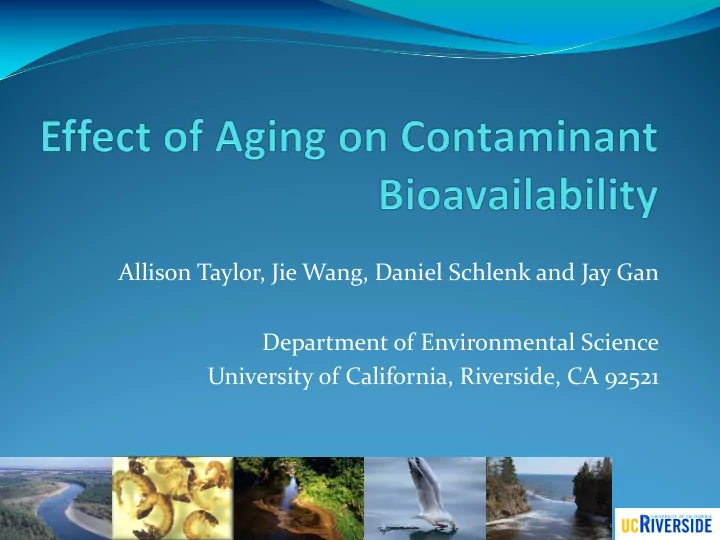

Allison Taylor, Jie Wang, Daniel Schlenk and Jay Gan Department of Environmental Science University of California, Riverside, CA 92521
“Priority” Organic Pollutants (HOCs) • Chlorinated pesticides • PCBs/PBDEs FACT 1: Strong sorption • PAHs • Dioxins • Chlorinated pesticides • PCBs/PBDEs FACT 2: Aged • PAHs • Dioxins 2
DDT • Paul Hermann Müller, Nobel Prize in Physiology or Medicine, 1948 • During World War II, control malaria and typhus among civilians and troops • Agricultural insecticide since 1945 • Banned in 1972 in the U.S. 3
Aging and Bioavailability plant roots microbes organic matter dissolved OM Freely dissolved benthic invertebrates 4
Aging and Bioavailability plant roots microbes organic matter Bioaccessible dissolved OM benthic invertebrates Freely dissolved 5
Aging and Bioavailability plant roots Non-accessible microbes organic matter Bioaccessible dissolved OM Freely dissolved benthic invertebrates 6
Aging and Bioavailability plant roots Non-accessible microbes organic matter dissolved OM Bioaccessible benthic invertebrates Freely dissolved 7
Measuring Bioavailability Irreversibly bound Irreversibly bound Irreversibly bound Reversibly Freely Reversibly Reversibly bound Freely Freely dissolved bound bound dissolved dissolved Equilibrium sampling Bioaccessibility Total concentration C free Reichenberg and Mayer, ET&C, 2006, 1239-1245
Bioavailability Freely dissolved concentration C free The potential for a chemical to undergo spontaneous processes, e.g., diffusion and partitioning Bioaccessibility The actual amount of a chemical that is or may become available within a given time and under given conditions Freely Total Bioaccessible dissolved Risk concentration Concentration Concentration Bioavailability Reichenberg and Mayer, 2006, Environ. Toxicol. Chem. 25, 1239-1245
Bioavailability Methods Bioaccessibility C free • Passive samplers • Partial desorption • DGT • Weak acid extraction • Polyethylene devices • Mild solvent extraction (PEDs) • Gut fluid extraction • Semi-permeable • Cyclodextrin extraction membrane devices • Tenax adsorption (SPMDs) extraction • Polyoxymethylene • Isotope dilution (POM) method (IDM) • Solid phase micro- extraction (SPME)
Study I. Aged POPs at the Palos Verdes Superfund Site Health Warnings : US EPA, 2010
A Sediment Core Experiment • Hypothesis: • Contaminant aging has resulted in reduced bioavailability.
210 Pb Dating
Total Concentrations A) B) 2000 2000 2000 2000 1980 1980 1960 1960 1980 1980 1940 1940 Year Year Year Year 1960 1960 1920 1920 1900 1900 1940 1940 PCB 153 p,p'-DDD 1880 PCB 153 1880 p,p'-DDD PCB 70 p,p'-DDE PCB 70 p,p'-DDE 1860 1860 PCB 52 o,p'-DDE PCB 52 o,p'-DDE 1920 1920 0.0 2 3 3 3 1 2 2 2 0.0 4 4 4 4 5 0 0 3 3 3 3 4 5.0x10 1.0x10 1.5x10 2.0x10 2.0x10 4.0x10 6.0x10 8.0x10 1.0x10 . 0 0 0 0 . 0 0 0 0 0 0 0 1 1 1 1 1 1 1 1 1 x x x x x x x x x 0 0 5 0 0 0 0 0 0 . . . . 5 1 1 2 . . . . . 2 4 6 8 1 Total Concentration ( µ g/kg) Total Concentration ( µ g/kg) Total Concentration ( µ g/kg) Total Concentration ( µ g/kg) Total concentration profiles of PCBs and DDTs in ( A ) 8C and (B) 3C cores in µg/kg dry weight (d.w.) of sediment.
Tenax Results 3C 8C
Conclusions I • DDT residues were extensively “aged”. • Due to aging, only a very small fraction of DDTs in the marine sediment was “bioaccessible”. • DDTs in surface sediment also showed very low bioaccessibility. • DDT residues were “aged” elsewhere before deposition onto the ocean floor • Implications: • Risks much lower than expected from total concentration • EPA decided to use MNA (“monitored natural attenuation”) instead of capping.
Study II. A Direct Method to Test Aging Isotope-labeled HOCs Bioaccumulation assay Eisenia fetida ultrasonic extraction Historically-contaminated soil SPE purification
Bioaccumulation assay Isotope-labeled HOCs Nereis virens ultrasonic extraction Historically-contaminated marine sediment SPE purification
Bioaccumulation assay Isotope-labeled HOCs ultrasonic Lumbriculus variegatus extraction Historically-contaminated freshwater sediment SPE purification
Tenax desorption Isotope-labeled Tenax HOCs beads Spiked soil/sediment Historically-contaminated soil/sediment transferring ultrasonic centrifuging & extraction transferring beads
1.2 1.2 1.2 soil B sediment 8C soil A native HOCs labeled HOCs 0.8 0.8 0.8 0.4 0.4 0.4 Bioaccessibility 0.0 0.0 0.0 PCB52 PCB70 DDE DDD DDT PCB52 PCB70 DDE DDD DDT PCB52 PCB70 DDE DDD DDT 1.2 1.2 sediment FW sediment 6C 0.8 0.8 C = 0.4 0.4 F Tenax 24h C total 0.0 0.0 PCB52 PCB70 DDE DDD DDT PCB52 PCB70 DDE DDD DDT Tenax F 24h of native HOCs were consistently smaller than those for isotope labeled HOCs, suggesting reduced bioaccessibility due to aging
native HOCs 20 12 soil A sediment 8C soil B labeled HOCs 0.3 15 Biota-to-soil/sediment accumulation factors 8 0.2 10 4 0.1 5 0 0 0.0 PCB52 PCB70 DDE DDD DDT PCB52 PCB70 DDE DDD DDT PCB52 PCB70 DDE DDD DDT 4 sediment FW sediment 6C 0.3 3 BSAF = C worm / f lip 0.2 C total / f oc 2 0.1 1 0.0 0 PCB52 PCB70 DDE DDD DDT PCB52 PCB70 DDE DDD DDT The BSAF values of native HOCs were consistently lower than those for isotope labeled HOCs, clearly indicating aging effect on bioavailability of POPs in environmental matrices
log labeled HOCs/native HOCs (Tenax) 3 y = (0.95 ± 0.09)x + (-0.12 ± 0.14) 2 =0.82 R p <0.05 2 1 0 -1 -1 0 1 2 3 log labeled HOCs/native HOCs (worm) • Ratios of labeled HOCs to native HOCs accumulated in earthworm, against against with the ratios of Tenax F 24h . • Highly significant linear correlation, with R 2 = 0.82, and slope close to 1.
Conclusions II • Compared to freshly spiked chemicals, bioaccumulation of aged residues was much lower • The same conclusion was made in marine sediment, freshwater sediment and soil, for different invertebrates • The use of chemically based measurement closely predicted bioaccumulation • The use of isotope labels is a direct and convincing technique to demonstrate the effect of aging on contaminant bioavailability.
Funding $upport
Recommend
More recommend